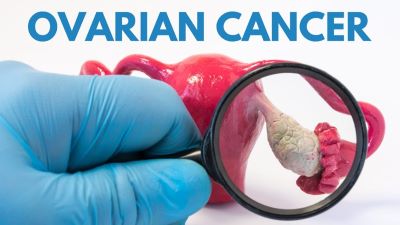Context
Ovarian cancer is the deadliest gynaecological cancer and is frequently referred to as a “silent killer” due to its vague symptoms, which can resemble those of less severe conditions, leading to late diagnosis and a poor outlook. In India, it is one of the top three cancers affecting women, accounting for 6.6% of all female cancer cases.
Overview
- In 2022, India recorded 47,333 new cases of ovarian cancer and 32,978 deaths, underscoring the severity of the disease. By gaining insight into the lesser-known aspects of ovarian cancer, we can improve prevention, early detection, and treatment strategies, providing hope for both patients and healthcare professionals.
- Ovarian cancer often shows vague symptoms such as bloating, pelvic pain, loss of appetite, and frequent urination, which can be mistaken for less serious issues. A 2004 study found that women with ovarian cancer experience these symptoms 20 to 30 times a month, with greater severity than those without the disease. Due to the overlap with common conditions, these symptoms are often ignored until the cancer progresses. Healthcare providers should remain alert to persistent symptoms reported by women.
Ovarian Cancer Subtypes:
- Ovarian cancer is not a single disease: but it consists of two primary subtypes: type I and type II.
- Type I tumours are less frequent, usually identified at an earlier stage, and tend to have a better prognosis.
- Type II tumours are more prevalent, more aggressive, often diagnosed at a later stage, and account for the majority of ovarian cancer-related deaths.
- Type I tumours are less frequent, usually identified at an earlier stage, and tend to have a better prognosis.
- Survival rates: for ovarian cancer vary by detection stage and treatment access. As of September 2022, about 20% of patients with advanced ovarian cancer who receive optimal surgery and platinum-based chemotherapy may be disease-free at 10 years and potentially considered cured
- Lacks effective routine screening tests: Unlike breast or cervical cancer, ovarian cancer lacks effective routine screening tests. The CA125 blood test, often included in screening packages, is not recommended for average-risk women due to its limited specificity. While useful for monitoring diagnosed ovarian cancer, CA125 is less effective for screening asymptomatic women and can lead to false positives, unnecessary tests, anxiety, and over-treatment.
- Lacks of reliable screening tool: With no reliable screening tool available, awareness of risk factors and symptoms is essential. Regular consultations with healthcare providers and discussions about family history can improve early detection and management of ovarian cancer.
Genes and endometriosis.
Ovarian cancer can occur without a family history, but it's the most heritable cancer, with 65-85% of hereditary cases involving BRCA1 or BRCA2 gene mutations. Women with BRCA1 mutations have up to a 50% risk, while BRCA2 mutations confer about a 15% risk. Other genes are also linked to hereditary ovarian cancer. Genetic testing enables personalized risk management, including tailored surveillance, chemoprevention, and preventive surgeries. Endometriosis, where uterine-like tissue grows outside the uterus, is associated with a higher risk of certain ovarian cancers like endometrioid and clear-cell types, but the overall risk remains low, making radical preventive measures rare.
Lifestyle Factors
Several lifestyle factors may influence ovarian cancer risk:
- Talcum Powder: The potential link between talcum powder use in the genital area and ovarian cancer has been debated, with mixed evidence. While some older talc products contained asbestos, a known carcinogen, the impact of modern asbestos-free talc remains inconclusive. Experts, including the American Cancer Society, have called for further research.
- Hair Products: Emerging concerns involve chemical hair products. Some studies suggest a possible link between prolonged use of hair dyes and an increased risk of ovarian cancer. Frequent use of hair straighteners, relaxers, or pressing products that release formaldehyde—a known carcinogen—might also raise ovarian cancer risk, though more research is needed.
HRT, Menopause, and Genetic Counselling
- Hormone Replacement Therapy (HRT): HRT, used to manage menopausal symptoms, has been associated with an increased risk of ovarian cancer, even with use for less than five years. Postmenopausal women should consider this risk alongside the benefits and discuss alternatives with their healthcare provider to make well-informed decisions.
- Genetic Counselling: For women with a family history of ovarian or breast cancer, genetic counselling is crucial. It helps identify those at higher risk for hereditary cancers and offers personalized advice on preventive measures and treatments. This tailored approach can enhance outcomes and potentially lower the risk of ovarian cancer.
- Ovarian Cancer Awareness: While ovarian cancer can be elusive, understanding its subtler aspects—such as symptoms, genetic factors, and lifestyle risks—can facilitate earlier detection and more personalized treatment. During Ovarian Cancer Awareness Month this September, spreading this knowledge can empower individuals and save lives.
Conclusion
Ovarian cancer, though less frequently discussed, poses a significant health risk due to its often vague symptoms and late-stage diagnosis. It is the deadliest gynaecological cancer. It plays a crucial role in hereditary ovarian cancer risk, and genetic testing can offer tailored risk management strategies. Here more research is needed; genetic counselling provides valuable support for those with a family history of the disease. Raising awareness about ovarian cancers subtle symptoms, risk factors, and preventive measures is essential for improving early detection, treatment outcomes, and overall survival.
|
Probable question for upsc mains
|
Source : the Hindu







